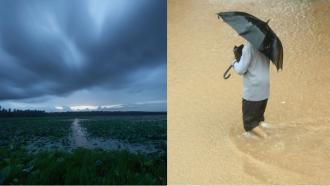
It’s the monsoon season in India, and while you sip your chai and enjoy the beauty of rains, have you wondered why we have torrential monsoon rains in India but not in other parts of the world, like Europe? The South Asian summer monsoon, which brings rains to most parts of India, is one of the several monsoon systems in the world, including those in tropical Africa, East Asia, and Australia that receives heavy downpour during the rainy monsoon season. On the other hand, there are deserts in the Sahara, Arabia, central Australia and inland Asia, which may not see any rain for years at a stretch. So, when and how did these climatically different regions come to be?
A recent study, by researchers from China, USA and UK, has shed new light on the formation and evolution of the Asia-Africa-Australia monsoon and arid regions and the factors that controlled them, during the Cenozoic Era. The Cenozoic Era is a geological period in the Earth’s history extending from about 65 million years ago to the present day. The study, published in the journal Science China: Earth Sciences, builds on existing geological evidence pointing to significant changes in the geology of the planet leading to the formation of these regions.
“Our modelling results indicate, for the first time, that the time of origin and the causes of formation of monsoon and arid regions in Asia, Africa, and Australia are very different,” says Dr. Liu Xiaodong from the Institute of Earth Environment, Chinese Academy of Sciences, who is the lead author of the study. “They are the consequences of the interactions among the different spheres of the earth system”, he says, talking about how these regions came to be.
In this study, the researchers simulated the climate of the planet during five different periods of the Cenozoic Era. The simulations were built upon geographical conditions during each of these periods, which were based on available geological evidence. The simulations were conducted using a complex mathematical model defining the global atmospheric and ocean circulations present during that time. A ‘monsoon region’ in the simulation was a region where the summer rainfall is significantly higher than the winter precipitation, and an arid region was one where the annual rainfall is lower than 400 mm.
The study found that positions of the continents, which are drifting according to plate tectonics, play a significant role in the formation of arid and monsoon regions. Continental drift, as it is called, is caused by the movement of tectonic plates, which results in landmasses gliding over the Earth’s mantle. The mantle lies between the Earth’s outermost layer called the crust, and the inner, hotter, core and behaves like a viscous fluid as it contains molten rocks. The tectonic plates that float on the molten liquid in the mantle move due to currents, thus resulting in phenomena like earthquakes, volcanic eruptions and continental drift.
One of the most prominent continental drifts occurred around 40 million years ago when the Indian plate collided with the Eurasian plate, causing the formation of the Tibetan Plateau and the Himalayas. This collision, along with the Inter-Tropical Convergence Zone (ITCZ) played a crucial role in the creation of South Asian monsoon, say the researchers. The Inter-Tropical Convergence Zone is a low-pressure zone around the equator that migrates, in the tropical latitudes, seasonally and controls the global air and water circulation.
In contrast, the African plate did not move much during the Cenozoic, and hence, the monsoon regions in the northern and southern Africa existed since the early Cenozoic period. The existence of arid regions in the Sahara can be attributed to the formation of a high-pressure area influenced by the descending movement of air in the subtropical latitudes. Likewise, around 10 million years ago, the Australian continent drifted northward, closer to the equator, causing the evolution of the northern Australian monsoon and appearance of a vast arid region in central Australia.
During the same period, the Tibetan Plateau continued to uplift, directly influencing the formation of arid regions in Asian interiors and the East Asian monsoon, says the study. However, the desert region in the Arabian Peninsula formed as the Paratethys Sea—an ancient shallow sea which extended from the Alps to Central Asia—shrank between 40-25 million years ago.
This study combines mathematical modelling results with geological evidence to explain the evolution of monsoon and arid regions in Asia, Africa and Australia, which was hitherto based on assumptions, to simplify the real-world conditions. However, it acknowledges certain uncertainties in the findings relating to contradictory geological evidence from different periods used in this study.
“These uncertainties could have a certain impact in determining the exact timing, but it does not affect the main conclusion on the evolution of the Cenozoic monsoon and arid regions obtained in this study,” assures Dr Liu. Further studies, he says, will lead to more accurate insights into the exact time and mechanisms in which these climatic regions might have evolved.
This article has been run past the researchers, whose work is covered, to ensure accuracy.






